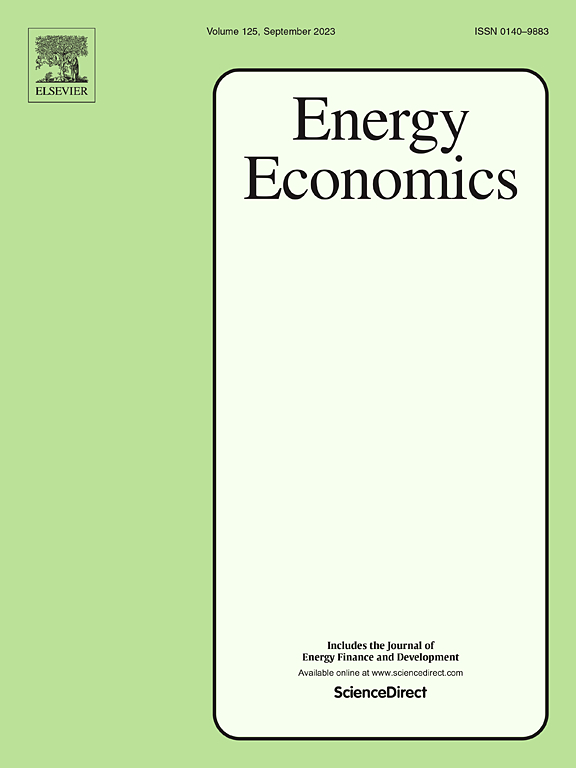波特假说与污染避风港假说:环境政策能产生双赢的解决方案吗?
IF 14.2
2区 经济学
Q1 ECONOMICS
引用次数: 0
摘要
本文在两国两企业模型下,研究了环境政策对企业区位和绿色创新的影响。为了解决这个问题,我们解决了一个两阶段博弈。在第一阶段,企业有三种选择:留在母国投资绿色技术;留在母国,用一切照旧的技术生产;或者搬到污染严重的地方。在第二阶段,企业在满足本国需求的同时进行数量竞争。尽管模型是对称的,但我们的研究结果表明,所有的市场配置——无论是对称的还是不对称的——都可以成为博弈的子博弈完美纳什均衡。这包括一个“双赢”的解决方案,即两家公司都选择留在本国,投资绿色技术,这证实了波特假说的“弱”版本。值得注意的是,即使在看似不利的条件下,搬迁到污染避风港的设置成本也相对较低,这种结果也可能发生。该模型预测,更严格的环境政策有利于波特假说,因为“双赢”的解决方案更有可能作为博弈的均衡而出现。我们的分析考察了两种政策情景——排放税和排放标准——发现排放税可以诱使企业在标准无法做到的情况下留下来并投资绿色技术,从而证实了波特假说的“狭义”版本。本文章由计算机程序翻译,如有差异,请以英文原文为准。
Porter Hypothesis vs. Pollution Haven Hypothesis: Can an environmental policy generate a win–win solution?
This paper investigates the effects of environmental policy on firms’ location and green innovation for a two-country, two-firm model. To address this issue, a two-stage game is solved. At the first stage, firms can choose between three actions: to stay in the home country and invest in a green technology; to stay in the home country and produce with the business-as-usual technology; or to move to a pollution haven. At the second stage, the firms compete in quantities while serving the demand in the home country. Despite the model is symmetric, our findings indicate that all market configurations – both symmetric and asymmetric – can be a subgame perfect Nash equilibrium of the game. This includes a “win–win” solution where both firms choose to stay in the home country and invest in green technology confirming the “weak” version of the Porter Hypothesis. Remarkably, this outcome can occur even in seemingly adverse conditions with relatively low setup costs of relocating to a pollution haven. The model predicts that a stricter environmental policy plays in favor of the Porter Hypothesis because the “win–win” solution becomes more likely to arise as an equilibrium of the game. Our analysis examines two policy scenarios – an emission tax and an emission standard – finding that the emission tax can induce firms to stay and invest in green technology under circumstances for which the standard cannot, confirming in this way the “narrow” version of the Porter Hypothesis.
求助全文
通过发布文献求助,成功后即可免费获取论文全文。
去求助
来源期刊

Energy Economics
ECONOMICS-
CiteScore
18.60
自引率
12.50%
发文量
524
期刊介绍:
Energy Economics is a field journal that focuses on energy economics and energy finance. It covers various themes including the exploitation, conversion, and use of energy, markets for energy commodities and derivatives, regulation and taxation, forecasting, environment and climate, international trade, development, and monetary policy. The journal welcomes contributions that utilize diverse methods such as experiments, surveys, econometrics, decomposition, simulation models, equilibrium models, optimization models, and analytical models. It publishes a combination of papers employing different methods to explore a wide range of topics. The journal's replication policy encourages the submission of replication studies, wherein researchers reproduce and extend the key results of original studies while explaining any differences. Energy Economics is indexed and abstracted in several databases including Environmental Abstracts, Fuel and Energy Abstracts, Social Sciences Citation Index, GEOBASE, Social & Behavioral Sciences, Journal of Economic Literature, INSPEC, and more.
 求助内容:
求助内容: 应助结果提醒方式:
应助结果提醒方式:


